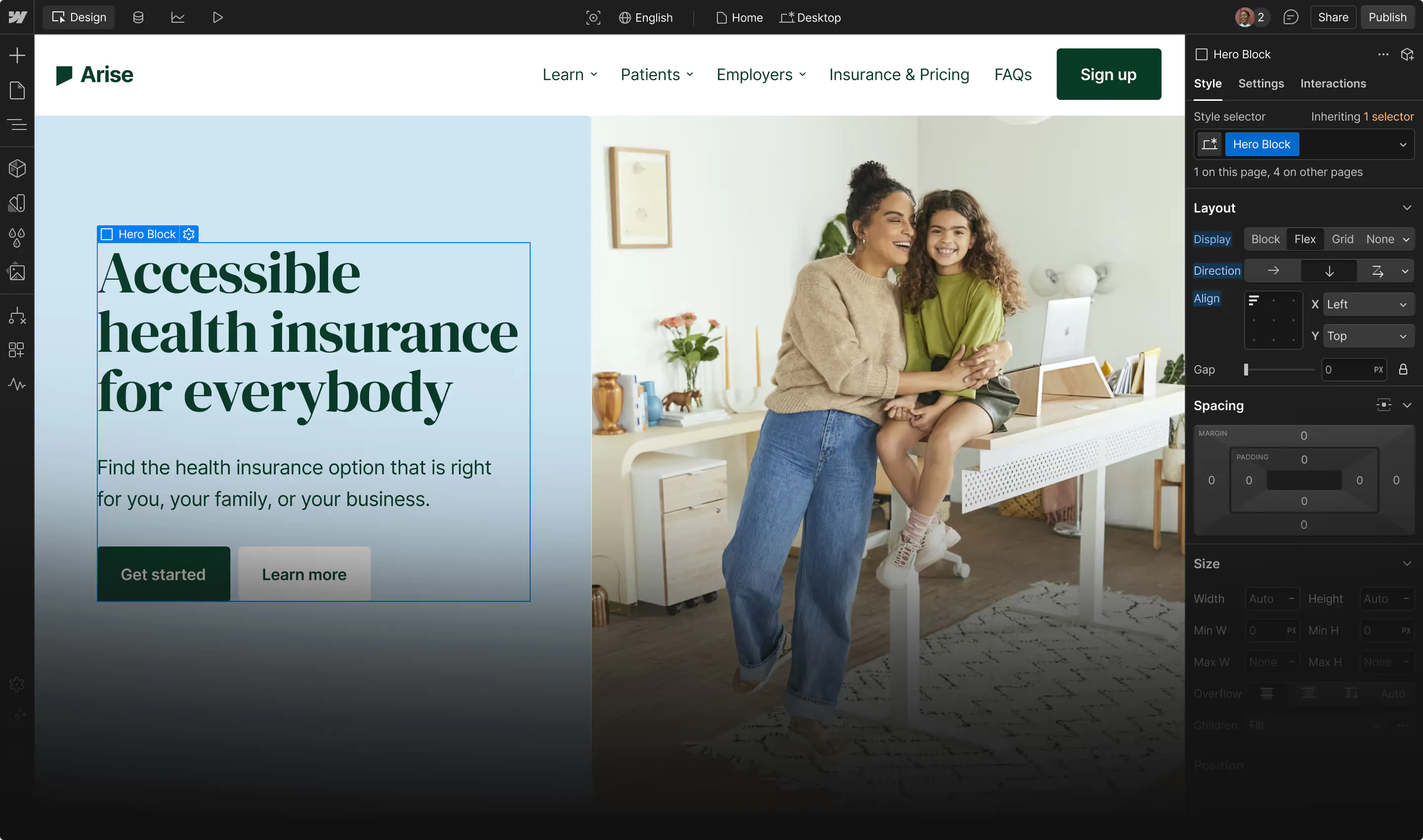Site migrations can be daunting, but two leading agencies share their battle-tested strategies for turning complex transitions into success stories for their clients.
Moving a website from one platform to another can be a complex undertaking. With proper planning and execution, however, migrations to Webflow can transform your clients' digital presence. In this article, two experienced Webflow Partners — Matt Sims from Flow Guys and Benoît Eveillard from Justa — share their insights, processes, and client success stories.
Why organizations are migrating from WordPress to Webflow
Organizations are increasingly looking to overcome limitations of traditional platforms like WordPress. Matt, from dedicated Webflow agency Flow Guys, regularly hears clients report that they feel constrained by WordPress’s reliance on plugins and third-party tools, which often introduce security vulnerabilities, increase load times, and complicate site management.
Flow Guys and Justa hear consistent motivations for making the switch to Webflow when discussing migrations with clients:
- Marketing team autonomy — Benoît describes the main challenge companies face with WordPress is the lack of autonomy for Marketing teams: “They don’t want to depend on tech anymore. Once we built the website, Marketers have full autonomy to create new pages, content, and campaigns.”
- Enhanced design flexibility — Matt notes that unlike WordPress, which often requires difficult-to-modify custom themes or templates, Webflow allows for completely custom designs. This flexibility is a game-changer for businesses wanting a unique, modern, and future-proof web presence.
- Improved security — While WordPress users may face issues from plugin or theme vulnerabilities, Webflow eliminates the need for frequent plugin updates, security patches, and developer maintenance.
- Better collaboration — Several team members can work simultaneously: a developer in Design mode, content manager in the CMS, and someone creating landing pages on Build mode.
- Reduced developer dependency — Teams can launch landing pages, update content, and maintain brand consistency without waiting for development resources. Matt shares that one client "reduced their reliance on external development support by 70%" after migration.
- Improved SEO performance — After migration, one Flow Guys client saw a 25% increase in organic search traffic within three months. Improved page speed, better site structure, and enhanced metadata handling played a crucial role.
Website platform migrations can be tricky, but they help organizations break free from legacy constraints and be more agile, reducing the time-to-market for critical campaigns.
Planning your clients’ migration strategy
Successful website migrations require thoughtful planning and clear communication. Every migration is unique, so you should begin the process by defining your client's goals and identifying any pain points with their existing platform. Some clients prioritize flexibility and design freedom, while others seek faster page load speeds, better SEO performance, or simpler content management.
Initial assessment and planning
A critical early step is creating a content document that maps out the new site’s structure, outlining every page, its content, and any changes. Developing a comprehensive communication plan to keep stakeholders informed during the migration is essential. Regular check-ins and clear timelines align teams and prevent last-minute surprises.
Justa recommends creating a collaborative roadmap with:
- The SEO/Content team
- Analytics/Data team
- Growth team
- Project owner
SEO migration strategy
Both Justa and Flow Guys emphasized that teams should prioritize search engine optimization (SEO) from the outset. Benoît notes that SEO is the most critical risk during a migration. Preserving SEO rankings and traffic during a migration is critical for clients’ continued success.
Before migration, your SEO strategy should include mapping existing URLs to new ones, setting up 301 redirects, and transferring metadata like page titles, descriptions, and structured data. Proactive planning reduces the risk of ranking drops or traffic loss after launch.
At Justa, their SEO process includes:
- Using Apify to crawl and detect all content, and create an inventory of resources to migrate, including static and dynamic pages
- Removing outdated or unused content, which can benefit SEO during a migration
- Maintaining constant communication and transparency with the client
- Identifying other critical points, including page functionality (e.g., a fee calculator), URL structures, user-generated content, and content components in the CMS
The migration process & key considerations
Every agency’s workflow may be different, but each migration process is a multi-step journey involving content, design, development, and SEO — with key considerations for each stage.
Flow Guys’ migration framework follows these main steps:
- Discovery and goal setting — Understanding the client’s goals and pain points is crucial. Each client’s vision informs the strategy, from design updates to functional improvements and SEO preservation.
- Content analysis & migration — We audit existing content, identifying what’s worth migrating and what should be retired. To streamline this process, we leverage our proprietary tool, Migratify, which facilitates the transfer of legacy blog content from WordPress to Webflow to maintain SEO value. A clear content document serves as a blueprint for the new site’s structure.
- Wireframing — Using Figma, we create low-fidelity wireframes to visualize the site’s structure, allowing clients to review and approve layouts before design and development start.
- Design — Our approach aligns the website’s visual design with brand guidelines and user experience best practices. We focus on creating consistent, modern aesthetics that resonate with target audiences and support the client’s business objectives.
- Development — We follow a documented style system for well-organized, scalable, and easy-to-maintain sites. We prioritize mobile responsiveness, scalability, and intuitive CMS structures.
- SEO preservation — We map redirects, transfer meta tags, and implement performance optimizations to protect or improve search visibility. Our Migratify tool supports the smooth transfer of SEO-critical elements, ensuring metadata, redirects, and URL structures remain intact. Our SEO-first approach ensures no ranking opportunities are lost.
- Functionality and integrations — If the site relies on third-party tools or integrations (like HubSpot, Mailchimp, or CRM systems), we replicate them in Webflow or connect them via Webflow’s integrations.
- Quality assurance & testing — We conduct rigorous QA testing to identify and resolve bugs, performance issues, or content discrepancies.
- Launch & post-launch support — We ensure a smooth go-live process, provide training to internal teams on how to manage the site, and offer ongoing support packages for future updates and maintenance.

Migrate your site to Webflow
Unlock your site's potential with Webflow. Migrate to a visual web platform, powerful hosting, and unmatched performance.
Real client success stories and results
Both agencies have achieved remarkable results for their clients from successfully migrating their sites to Webflow. Flow Guys’ clients have seen tangible improvements in their web operations and marketing performance after migrating, including:
- Faster campaign launches in hours, not weeks. No development bottlenecks mean teams can respond to market demands in real time.
- Improved SEO performance and traffic in three months.
- Reduced reliance on external development support.
One of Justa's notable successes is their work with Sogexia, whom they helped migrate in July 2024. The project had unique challenges, particularly with migrating years of content across four languages, while maintaining complex URL structures and preserving SEO rankings.
The Justa team developed a migration strategy and testing process to ensure all content remained accessible without compromising their SEO. They addressed existing technical issues during the migration, including implementing a proper sitemap and fixing 404 errors and rich snippets.
The results were impressive: Sogexia achieved a 30% increase in organic traffic post-migration. The new site has over 500 blog articles and 50 static pages in three languages using Webflow's native Localization. Most importantly, the marketing team gained complete autonomy over their content management, along with a fresh rebrand.
When we made the decision to migrate our WordPress website to Webflow, we had high expectations, but the results went above and beyond. The switch has revolutionized the way we manage our website, enabling faster updates, improving team productivity, and driving a 30% increase in organic traffic just six months after the transition.
Benjamin Bianchet, Chief Growth Officer at Sogexia
What are some key lessons learned?
Matt from Flow Guys shares his top lessons:
- Invest in planning — The more time spent on planning and discovery, the smoother the migration. Content audits, wireframes, and SEO mapping reduce errors and delays.
- Prioritize SEO from the start — SEO is not an afterthought. An SEO-first approach ensures clients retain their search engine visibility post-migration.
- Train clients to use Webflow — Clients feel empowered when they can manage their own content. Providing thorough training on Webflow’s CMS and Page Builder allows them to make changes with confidence and reduces ongoing developer support.
- Tailor the process to client needs — No two migrations are the same. Customizing the approach to each client’s business goals, functional needs, and design preferences creates better outcomes and stronger client relationships.
Benoît and the Justa team have migrated over 30 websites in 3 years, and say the key to site migrations is staying organized during these steps:
- Preparing the content for migration
- Migrating the content with high precaution
- Training the in-house team to use Webflow
- Test thoroughly before launching
More streamlined websites with Webflow
Website migrations to Webflow are a significant opportunity for your agency to deliver value to clients. These insights from trusted partners, Flow Guys and Justa, show that success depends on careful planning, clear communication, and technical precision. Remember that each migration is unique, but when executed well, the long-term benefits of improved efficiency, security, and team autonomy make them a worthwhile investment — strengthening your client relationships.
Learn more about how Webflow can help you deliver scalable sites, faster to your clients.

Build with Webflow
Break free from the constraints of traditional platforms. Migrate your site to visual-first platform that combines design flexibility with powerful CMS capabilities.




























